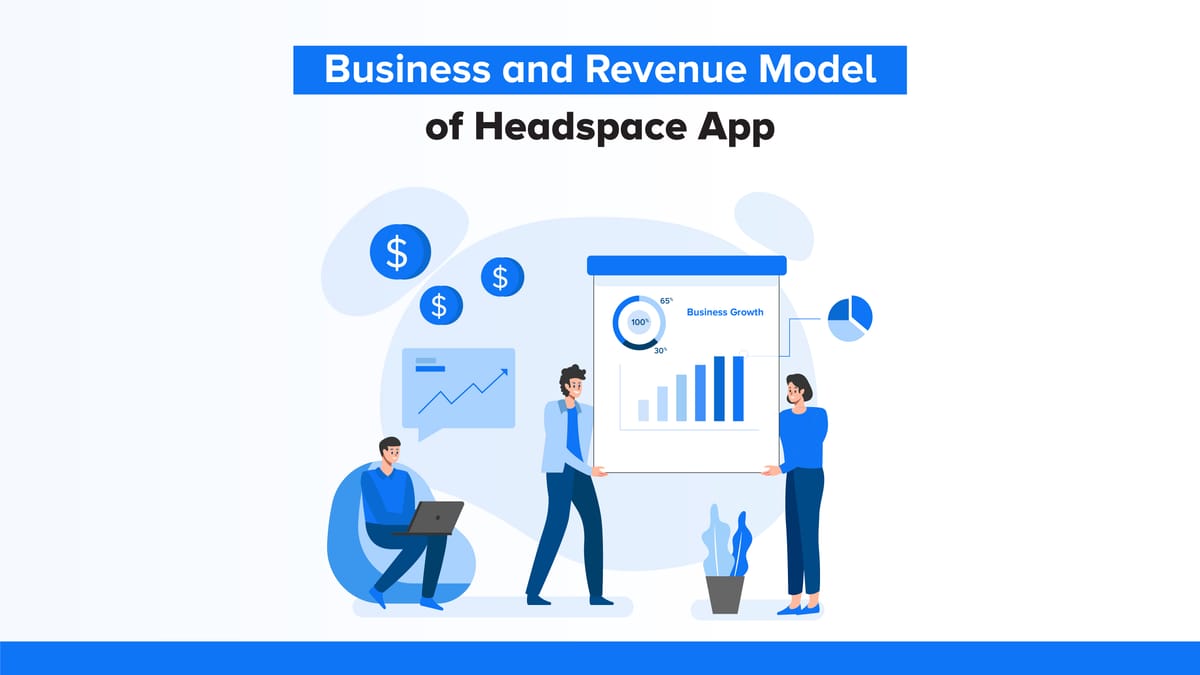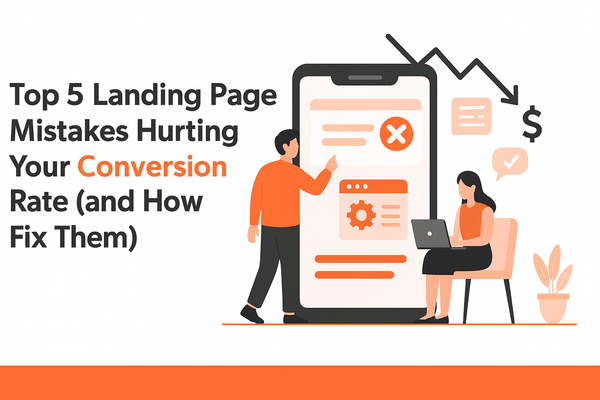Business & Revenue Model of Headspace App


It’s strange how a simple voice saying “breathe in, breathe out” could turn into one of the most successful wellness businesses in the world. But that’s the story of Headspace, a brand that made mindfulness mainstream and built a powerful business around peace of mind. Because mental health isn’t just personal anymore; it’s deeply social. It shapes how we live, love, and work, and the numbers say it all. Every 1 in 3 women and 1 in 5 men will face major depression at some point in their lives.
Furthermore, the coronavirus pandemic only magnified this shift. During the pandemic, when the world locked itself indoors and anxiety became a shared language, downloads of apps like Calm and Headspace surged, and so did their revenues. According to wellness app statistics, the global wellness app market generated nearly $880 million in revenue in 2024, with more than 50 million users.
So when an app helps millions of people find calm in the chaos and builds a thriving business while doing so, it’s worth understanding how it does so.
Let’s rewind to where it all began, the story behind Headspace.
Every global brand has a moment that defines its beginning. For Headspace, it started with one man’s quiet determination to bring calm to a restless world. Back in 2004, Andy Puddicombe returned to London after spending nearly a decade training as a Buddhist monk. He wasn’t chasing fame or funding; he simply wanted to help people reconnect with stillness in everyday life. That’s where he met Richard Pierson and later together, they both turned their vision into reality and in 2010 launched Headspace. Interestingly, at first, it was more of an events company where people could attend mindfulness sessions. But soon, a simple question from attendees changed everything:
“Can we take this experience home?”
That one question became the seed for what would grow into one of the world’s most popular mindfulness app. Andy recorded a few guided sessions like calm, clear, and rooted in his monk training, which quickly became the heart of the Headspace experience. His soothing British voice is still the app’s signature sound.
As the years unfolded, the app’s popularity began to outshine the live events. By 2014, Headspace had reached 1 million downloads, attracting attention from celebrities, wellness enthusiasts, and even major institutions like Virgin Atlantic and Harvard University.
Then came the real turning point in 2018. Headspace hit one million paid subscribers, marking 50% growth from the previous year, and has even been adopted by corporate giants like Google and LinkedIn.
Over the years, Headspace grew into much more than a meditation app. It began weaving mindfulness into everyday life through sleep sounds and focus music that clears the mind. The brand even found its voice in Radio Headspace, a podcast that feels like a thoughtful pause in a noisy world.
Even in 2020, the company teamed up with BBC Earth to launch Mindful Earth, a cinematic experience pairing nature’s beauty with guided meditation.
The evolution reached its next milestone in 2021, when Headspace merged with Ginger, an on-demand mental health platform. This merger combines the simplicity of self-guided meditation with professional clinical care that offers users everything from calm to counselling, all in one place.
Today, Headspace stands as one of the most trusted names in digital wellness, not because it followed a trend, but because it built one. And what makes headspace special is rooted in mindfulness, wrapped in technology. As of today, Headspace is used in over 200 countries and regions across the world, a quiet reminder that mindfulness speaks every language.
The Numbers Behind Headspace’s Success
Success for Headspace shows up in more than numbers; it’s seen in how many people truly rely on it and the quiet, genuine change it brings into their lives. Many companies turn to Headspace, hoping to reduce healthcare costs, believing that better mental health leads to better overall well-being. And while that’s true, the real win goes much deeper.
Take Adobe, for example. When the company offered free Headspace access to its employees, the results spoke louder than any campaign. As Sara Torres, Adobe’s Global Wellbeing Strategist, shared, “Many people already knew what Headspace was, and they were excited to download it. It’s been our shiny penny.”
And that story is just one reflection of a much bigger picture.
- Experts predict that the global wellness app market could grow to around $26.19 billion by 2030.
- Headspace has been downloaded over 70 million times.
- Over 2,700 companies partner with Headspace to offer employees free app access.
- Over 100 million lives have been touched through Headspace’s mindfulness programs.
- Headspace has become a leading mindful app, with over 2.8 million subscribers.
- Headspace was named one of Ad Age’s America’s Hottest Brands in 2020, as well as recognised in TIME100’s list of the Most Influential Companies in 2021.
- In October 2021, Headspace merged with Ginger, an on-demand mental health care company, to expand its mental health services.
- In 2022, Headspace bought Sayana, an AI-based mental health and wellness company, to grow its meditation business.
- North America took the biggest slice of the wellness app market in 2024, accounting for roughly 36% of total revenue.
- At the height of the pandemic, Headspace ranked as the second-highest-grossing meditation app, earning about $64.5 million in the first 11 months of 2020.
Business & Revenue Model of Headspace

Over the years, Headspace has evolved into three main pillars: the consumer app, corporate wellness solutions, and healthcare partnerships.
Each of these areas serves a different audience but connects through one shared goal that is improving mental well-being at scale. In every space it touches, Headspace has found a way to make calm both practical and scalable.
Headspace (Consumer App)
Headspace’s core business still revolves around its consumer app, the product that started it all. The app is free to download and provides basic lessons and features. Although offers a subscription model for advanced meditation and mindfulness courses that come with monthly and yearly plans. The monthly plan comes with a 7-day free trial, while the yearly plan offers a 2-week trial so new users can explore everything before subscribing. Moreover, its paid plan provides access to the full range of content, including more than 500 guided sessions covering topics like stress, focus, and better sleep. Today, more than 2.8 million people subscribe to Headspace.
Availability & Ratings: Available in both Apple and iOS App store.
- On Apple’s App Store, Headspace has a 4.8-star rating from almost 940,000 reviews.
- On Google Play (Android), it holds a 4.5-star rating from around 300,000 reviews.
Headspace for Work (B2B / Enterprise Solutions)
In today’s workplace, companies are finally putting their employees’ mental well-being first. Meditation apps like Headspace have become powerful tools for bringing calm and balance to busy teams. I’ve seen it myself, like how just a few mindful minutes can turn chaos into focus and help everyone reset.
To support organisations on a larger scale, Headspace offers its app through a Business-to-Business (B2B) program called Headspace for Work. The pricing isn’t publicly listed and typically depends on the company’s size and selected enterprise package.
And there are three plans to pick from:
Starter Plan
Includes an employee dashboard, monthly wellness tips, live events, reports, and 24/7 support.
Guided Plan
Adds a success manager, regular check-ins, and leadership reviews for better engagement.
Advanced Plan
Gives access to Headspace experts, co-branded events, and custom wellness programs.
Headspace Health (Clinical & Therapy Services)
A McKinsey study once highlighted something Headspace has always believed: not everyone needs the same kind of care, but everyone needs support. This idea inspired Headspace Health, the brand’s move into clinical care.
Headspace Health focuses on bringing mindfulness into the world of medicine. Its goal is to launch the world’s first prescription-based meditation app, designed to help people manage stress, anxiety, and chronic health conditions through guided, science-backed programs.
With this step, Headspace is expanding beyond wellness and into healthcare, combining therapy, coaching, and evidence-based meditation to support people who need deeper, more personalised care.

Growth Strategy & Market Outlook of Headspace
Headspace has come a long way from being “just a meditation app.” Today, it’s a global wellness brand built on smart strategy, empathy, and user trust. Here’s how the company continues to grow and stay ahead in the mental health space:
Building a Unified Mental Health Ecosystem
After merging with Ginger in 2021, Headspace became Headspace Health, combining meditation, therapy, and coaching on one platform. This blend made mental healthcare more convenient, offering both clinical help and everyday mindfulness in a single experience.
Listening and Adapting to User Needs
Headspace listens closely to these habits of the users and shapes its content around what users actually need. By adding flexible content like podcasts, playlists, and mindful workouts, the brand has made mental wellness fit naturally into people’s daily lives.
A Deep Focus on Simplicity and User Experience
What sets Headspace apart is its simplicity. From soft visuals to clear voice guidance, the app makes mindfulness effortless. Its design helps users stay calm, not distracted, proving that a peaceful user experience can be the strongest growth driver of all.
From Freemium App to B2B Platform
Headspace began with a freemium model, offering free basics and paid plans for deeper sessions. But as the wellness market evolved, it expanded into Headspace for Work, partnering with companies and universities to offer employee mental health programs. This shift opened up a strong B2B revenue stream alongside its app audience.
Smarter, more personal experiences with AI
Headspace is now bringing AI-driven personalisation into its app experience. In 2024, it introduced Ebb, an empathetic AI companion designed to tailor sessions based on user emotions and habits.
Conclusion
Headspace has built its success on something quietly powerful, a holistic way of bringing calm to modern life. With its range of meditations, fair pricing, and research-backed approach.
And honestly, what makes Headspace stand out is the ecosystem it’s built. From strong branding and intuitive design to smart use of AI and thoughtful partnerships, every part of the brand feels intentional.
As industries everywhere look for the next big thing, they could learn something simple from Headspace: growth doesn’t have to be loud to be strong. Sometimes, the smartest business model is the one that helps people breathe a little easier, and that’s exactly what great product design and technology should do.




